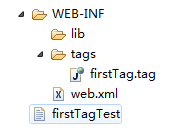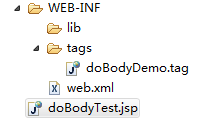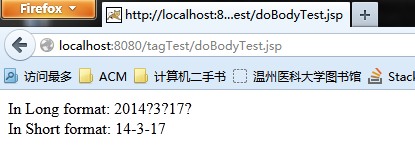⑦JSP2.0的福利(标签文件)
前言
本篇接着上一篇博客:[传送门]
这次讲的是JSP2.0的特性之一,我们可以编写标签文件,指没有标签处理器和标签类库描述符的定制动作指令,不编译,无标签类描述符。
本文结构:
①标签文件简介
②第一个尝试标签文件
#重点:标签文件指令
③doBody
④invoke
标签文件简介
tag文件只是以tag为后缀名的文本文件。除了jsp页面指令外,其他JSP元素都可以出现在tag文件中页面引用格式。一,不需要编译,只要jsp语法即可,这意味不懂java的人也可以编写。二,不许需要面搜标签库描述符。
格式:
<%@ taglib prefix="test" tagdir="/WEB-INF/tags" %>
tagdir:用于指定tag文件目录,当页面使用<ui:xxxx>进,会查找该目录下对应的xxxx.tag文件。
prefix:指定使用时标签前缀
使用:
<test:xxxx/>
第一个标签文件
包结构图和效果图(将服务器当前时间显示):


感兴趣不?往下看吧
firstTag.tag:
<%@ tag import="java.util.Date" import="java.text.DateFormat"%> <% DateFormat dateFormat = DateFormat.getDateInstance(DateFormat.LONG); Date now = new Date(System.currentTimeMillis()); out.println(dateFormat.format(now)); %>
firstTagTest.jsp
<%@ taglib prefix="easy" tagdir="/WEB-INF/tags" %>
Today is <easy:firstTag/>
#重点:标签文件指令
taglib、include、attribute、variable。
1)
<%@ tag display-name="" body-content="" dynamic-attributes="" small-icon="" large-icon="" description="" example=""language="" import="" pageEncoding="" isELIgnored="">
#tag 指令如同JSP网页的page指令,用来设定标签文件。
#display-name表示图形化开发工具显示<display-name>所指定 的名称;
#body-content表示可能的值有三种,分别是empty、scriptless、tagdependent、empty。
empty为标 签中没有主体内容,
scriptlet为标签中的主体内容EL、JSP动作元素,但不可以为JSP脚本元素,
tagdependent表示标签中的主体内 容交由tag自己去处理,默认值为scriptless;
#dynamic-attributes表示设定标签文件动态属性的名称,当dynamic- attributes设定时,将会产生一个Map类型的集合对象,用来存放属性的名称和值;
#small_icon表示在图形化开发工具显 示<small-icon>所指定的TLD相对路径的小图标,大小为16X16;
#large-icon表示在图形化开发工具显 示<large-icon>所指定的TLD相对路径的大图标,大小为32X32;
#description表示用来说明此标签文件的相关信 息;
#example表示用来增加更多的标签使用说明,包括标签应用时的范例;
#language、import、pageEncoding、 isELIgnored这些属性与page指令相对应的属性相同。
2)
<%@ attribute name="" required="" fragment="" rtexprvalue="" type="" description=""%>
这 个指令用来设定自定义标签的属性。其中name表示属性的名字;
required表示是否为必要,默认为false;
rtexprvalue表示属性值是 否可以为run-time表达式。如为true,表示属性可用动态的方式来指定,如:<mytag:read num="${param.num}"/>,如为false,则一定要用静态的方式来指定属性值;
type表示这个属性的类型,默认值为 java.lang.String;description用来说明此属性的相关信息
3)
<%@ variable name-given="" name-from-attribute="" alias="" variable-class="" declare="" scope="" desription="">
这 个指令用来设定标签文件的变量。其中name-given表示直接指定变量的名称;
name-from-attribute表示以自定义标签的某个属性值 为变量名称;
alias表示声明一个局部范围属性,用来接收变量的值;variable-class表示变量的类名称,默认值为 java.lang.String;
declare表示此变量是否声明默认值为true;scope表示此变量的范围,范围是:AT_BEGIN、 AT_END和NESTED,默认值为NESTED;description用来说明此变量的相关信息
········variable案例引出 doBody
jar结构 和 效果图


doBodyDemo.tag
<%@ tag import="java.util.Date" import="java.text.DateFormat"%> <%@ variable name-given="longDate" %> <%@ variable name-given="shortDate" %> <% Date now = new Date(System.currentTimeMillis()); DateFormat longFormat = DateFormat.getDateInstance(DateFormat.LONG); DateFormat shortFormat = DateFormat.getDateInstance(DateFormat.SHORT); jspContext.setAttribute("longDate", longFormat.format(now)); jspContext.setAttribute("shortDate", shortFormat.format(now)); %> <jsp:doBody/>
doBodyTest.jsp
<%@ taglib prefix="easy" tagdir="/WEB-INF/tags" %> <easy:doBodyDemo> In Long format: ${longDate} <br/> In Short format: ${shortDate} </easy:doBodyDemo>
新知识点-doBody-invoke
<jsp:doBody>与<jsp:invoke>动作元素,前者是用来处理卷标本体文字,后者则是用来设 定标签间的Fragment,下面两个动作元素搭配着attribute与variable两个指令元素。
首先介绍<jsp:doBody>您可以用它来决定是否显示本体文字,例如撰写如下的Tag File:
check.tag
<%@attribute name="password"%> <% if(password.equals("1234")) { %> <jsp:doBody/> <% } else { %> 密码不正确 <% } %>
必须先说明的是,这边使用了Scriptlet,这并不是一个良好的示范,若能搭配JSTL或自订标签库来完成Tag File的撰写会是比较好的,这边纯綷是为了说明方便才使用了Scriptlet。
上面这个Tag File会检查传入的属性password是否符合我们设定的密码,如果符合就执行<jsp:doBody>,表示显示卷标之间的本体文字, 否则显示密码不正确的讯息,attribute指令元素可以指定自订卷标所使用的属性文字,可以使用下面的JSP网页来测试:
test.jsp
<%@taglib prefix="caterpillar" tagdir="/WEB-INF/tags/" %>
<html>
<body>
<caterpillar:check password="${ param.pwd }">
您的秘密礼物在此!
</caterpillar:check>
</body>
</html>
您可以发现,Tag File即使是用来当作自订标签库的简便方式,也是十分的方便,不需要在tld档中作额外的设定,也可以得到相关的功能。
attribute除了指定属性文字之外,也可以将属性当作Fragment传入,方便在Tag File中作个别的处理,例如下面撰写一个table.tag:
table.tag
<%@attribute name="frag1" fragment="true"%> <%@attribute name="frag2" fragment="true"%> <table border="1"> <tr> <td><b>frag1</b></td> <td><jsp:invoke fragment="frag1"/></td> </tr> <tr> <td><b>frag2</b></td> <td><jsp:invoke fragment="frag2"/></td> </tr> </table>
在这个Tag File中,将attribute的属性设定为Fragment,然后想取得指定的Fragment的话,就可以使用<jsp: invoke>动作元素,并指定Fragment的名称,使用下面这个JSP网页来测试:
test.jsp
<%@taglib prefix="caterpillar" tagdir="/WEB-INF/tags/" %> <html> <body> <caterpillar:table> <jsp:attribute name="frag1"> Fragment 1 here </jsp:attribute> <jsp:attribute name="frag2"> Fragment 2 here </jsp:attribute> </caterpillar:table> </body> </html>
在JSP网页中,同样的是使用<jsp:attribute>来说定Fragment的文字内容,执行这个JSP网页,会传回以下的内容:
<html> <body> <table border="1"> <tr> <td><b>frag1</b></td> <td>Fragment 1 here</td> </tr> <tr> <td><b>frag2</b></td> <td>Fragment 2 here</td> </tr> </table> </body> </html>
在Tag File与JSP网页之间,可以使用variable指令元素设定Scripting Variable,以在两者之间传递变量内容,例如撰写以下的Tag File:
precode.tag
<%@attribute name="preserve" fragment="true" %> <%@variable name-given="code" scope="NESTED" %> <jsp:doBody var="code" /> <table border="1"> <tr> <td> <pre><jsp:invoke fragment="preserve"/></pre> </td> </tr> </table>
在这个Tag File中,使用variable设定Scripting Variable为"code",作用范围为"NESTED",也就是在起始卷标与结束卷标之间,而其中<jsp:doBody>中多了一项 属性var,表示在JSP网页中的<jsp:body>卷标中的文字内容将设定给"code"变量,可以用下面这个JSP网页来测试:
test.jsp
<%@ taglib prefix="caterpillar" tagdir="/WEB-INF/tags" %>
<html>
<body>
<caterpillar:precode>
<jsp:attribute name="preserve">
<b>${ code }</b>
</jsp:attribute>
<jsp:body>
PROGRAM MAIN
PRINT 'HELLO'
END
</jsp:body>
</caterpillar:precode>
</body>
</html>
<jsp:body>之间的虚拟程序代码将会传入给"code"变量,由于它是Scripting Variable,可以在标签之内起作用,所以在<jsp:attribute>中的EL式${code}可以取得Tag File中"code"的内容,也就是<jsp:body>传入的文字,之后我们将<jsp:attribute>的内容当作 Fragment在Tag File中作处理,结果将会如以下的网页:
<html> <body> <table border="1"> <tr> <td> <pre><b> PROGRAM MAIN PRINT 'HELLO' END </b></pre> </td> </tr> </table> </body> </html>
总结
寄读者,寄知识来源
读者,你好!你我不相识,谢谢你们支持。我的梦想会越来越接近。keep on,共勉!
知识来源 http://book.douban.com/doulist/3575997/




